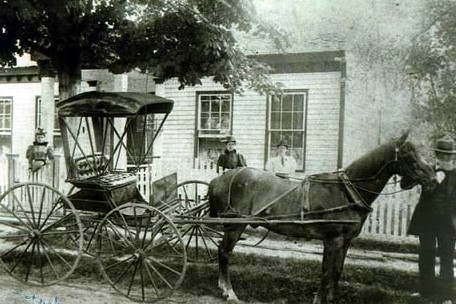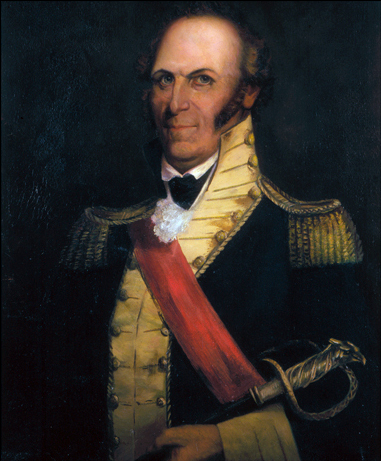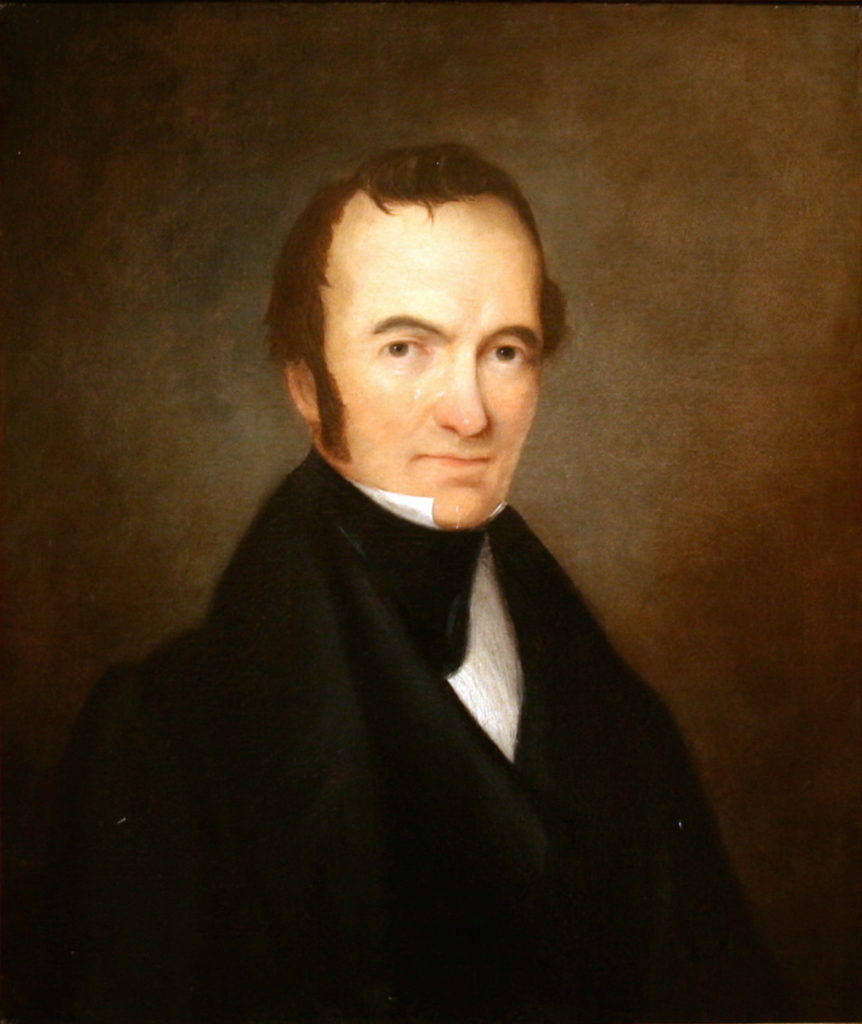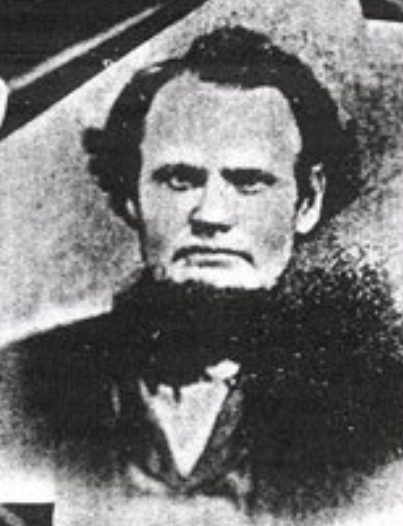Austin’s Milestones

Adam Reyonolds family in downtown Austin, 1885.

Circa 1930s, Morgan Packing Company Strikers
The Early History of Austin, Indiana
The story of Austin Indiana began in 1839, when a white settler named Isaiah Jones settled into the area and began clearing off the land where he built a log cabin home for his family. As Jones settled into his land, he became friends with local Indians, most likely Delawares that lived nearby. Jones faced many challenges as he cleared away the forests, along with the rigorous life of the daily hard labor he constantly had to deal with the threat of panther and bear attacks to his livestock.
As Jones continued to farm the area, and other settlers moved into the community, the small village remained a farming community until 1848, when the Pennsylvania Railroad began constructing a road through the village. Over the next couple of years there was significant change in the community, and soon people began to live nearby the tracks being graded in the town. By the late 1840s the Texas natives were already calling the community Austin, and by the early 1850s the community was filled by residents with diverse backgrounds. There were the early settlers still living in the area, along with the Texas natives, and the Irish immigrants that came to Austin to work on the railroad. The Irish immigrants were known to be hard workers, hard fighting and hard drinking.
On May 3rd, 1851, and with the railroad grading nearly complete, a gentleman named Morris Sarver purchased ten acres of land from Isaiah Jones. The land Sarver purchased was situated on both sides of the newly laid tracks, and to him should go the credit of having the first idea of a town on the railroad, even though he did nothing to develop the plan. In March of 1853, the land was sold to George A. and Katherine Rankin of New Frankfort, Indiana. George Rankin then formed a business venture with two men from New Frankfort, named Caleb H. Skeel and John Elsey. The three men now in control of the land and vision that once belonged to Sarver pursued the establishment of Austin as an official town.
Austin Officially Established as a Town
On May 3rd, 1853, Austin officially became established as a town. Scott County Justice of the Peace John Cantwell signed the voluntary act of the New Frankfort trio, George A. Rankin, John Elsey and Caleb Skeel. With that declaration the trio donated land and envisioned great opportunities as the now busy railroad ran right through the center of the town. The great steam engines made frequent stops in Austin, on their way to Indianapolis from Louisville, Kentucky.
Austin is located in south central Indiana, just 35 miles north of Louisville Kentucky, and is part of Scott County, Indiana. (The Austin city and rural areas are also part of Jennings Township). Scott County was formed on February 1st, 1820, and was named after General Charles Scott (1739-1813) of Virginia. Scott was a Revolutionary war hero who participated in a number of engagements against the Indians in Indiana and was the fourth Governor of Kentucky 1808-1812.
Purportedly the naming of Austin, Indiana, derived from War Veterans of the War with Mexico (1846-1848). An appreciative United States government offered Veterans of the war, land in Indiana as a gift for their services to their country. The Veterans arrived from Texas and after settling into the village, they named the community Austin, in honor of Austin Texas where several of them once lived.

General Charles Scott

Stephen F. Austin
A Quick Story of Austin, Texas
Austin, Texas, became an official community in 1839, but was known as Waterloo prior to the name of Austin. In the early 1830s Anglo-Americans arrived in central Texas and settled along the banks of the Colorado River. In 1839, when Texas was searching for a centrally located capital; Waterloo was renamed Austin, Texas, in honor of Stephen F. Austin (1793-1836). Stephen F. Austin was affectionately known as “The Father of Texas.”
Stephen F. Austin was born in the mining regions of southwest Virginia in what is now known as Austinville, also named after him. In the state of Texas, Stephen F. Austin along with Sam Houston are revered as the two most heroic and influential men in the history of Texas. The state office building is named after Austin, as are both Austin, Texas, and Austin County, Texas. Along with communities bearing the Austin name in Texas, there is the Stephen F. Austin University in Nacogdoches, and Austin College in Sherman, Texas. Several grade and high schools are also named after Austin. So that’s how Austin Indiana got its name in 1853, after Austin, Texas, which originally was named after Stephen F. Austin, “The Father of Texas.”
Austin in 1880
The article below is from the July 1st Austin Chronicle 1880 edition. The story was reprinted by the Scott County Journal July 7th, 1977 edition.
“Austin has 287 inhabitants; two dry goods and grocery stores conducted by two of Indiana’s best and ablest country merchants, Thomas Hughbanks and John W. Montgomery both self-made men.
One drug store owned by Benj. F Henslee, an enterprising and reliable man who has made all he has since the since the Civil War. “
“One confectionary owned by Stuart Johnson, a clever reliable self-made man. One hardware store owned by Robert Walker and one Government licensed Whiskey house owned by Albert H. Denney. Three millinery stores owned by Mary Rickets, Mrs. Dora Ogden and Mrs. Ann Wilson. Three dressmakers Mrs. Jane Crawford, Miss Mary Rickets and Mrs. Eva Rogers.”
“One Stave and Heading Factory owned by J.C. Thompson, a clever gentleman and a fine businessman, giving constant employment to about ten hands and a portion of the time, 25 or 30.”
“One chair split and furniture owned shop by James S. Owens, giving employment to five to eight hands. Two wood shops owned by Benj. F. Foster and James Owens who make wagons and buggies. Two blacksmith shops where you can get a wagon ironed, or a horse shoe or any kind of work done by Adam Reynolds or the Ogden bros., Oscar and Eugene. One copper shop owned by James Spurgeon and one Hoop shaving shop owned by Elias Mitchell who employs four or five hands.”
“One Cabinet and Undertaker’s shop owned by Esq., L.H. Baldwin where you can get anything you want in the furniture line and just what no one wants (a coffin). A post office conducted by Oscar Ogden who is a dealer of cigars and stationary and knows how to do the clever. The Masons and Odd Fellows are both flourishing with halls of their own. A graded school conducted by Prof. A.N. Munden and Miss Alice Hoover having school ten months in the year, a free term, a spring term and summer normal, our schools under the supervision of Prof. Munden are SECOND TO NONE in the state of the kind.”
“Mr. and Mrs. Ira Herald and son buy all the old iron and copper in the country and pay you anything you want in tin or glass line. One hotel owned and conducted by Stuart Johnson and wife, where there is ample accommodation for man and beast. One lawyer A.N. Munden, one Notary Public John W. Montgomery, two Justices of the Peace L.H. Baldwin and J.H. Statton, one Constable Harvey Alexander.”
“Two physicians Henry R. Casey and Sion M. Rogers, both gone to farming (be) cause (of) no sickness. Two churches the Methodist and Christian, both having good houses in a flourishing condition.”
“One Newspaper, published by B.F. Foster and son and edited by Will M. Foster a young man of 18 summers, for whom we predict a brilliant and useful future, being a young man who never says I can’t.”
“This part of Indiana is splendid farming country. The average yield of corn is about 35, wheat 14, oats 25 bushels per acre. It is perhaps the best portion of the state, for grass often producing two tons per acres. Stock growing of all kinds is also very profitable here. This is the most splendid country for grapes as they grow and mature splendidly any place in this (Jennings) township.”
“R”
Austin, June 25, 1880.
Native American Life in Austin, Indiana
Long before the white-man settled in Austin in 1839, the area was inhabited by Native Americans Indians. Archeologists and Scientists have determined that thousands of years ago, around the ice age period that Austin was home to several different generations of Indians.
Around 15,000 years ago and near the end of the glacial period, Archeologists have found evidence that in south Austin the Paleoindians lived along the shore line of a great lake that was 17 miles long and covered areas in what is now known as Washington and Scott Counties. The lake no longer exists but the vast number of creeks and small rivers attest to its existence. The Paleoindians were believed to have migrated from Asia into North America.
After the Paleoindian era Austin was then inhabited by the Archaic Indians some 6-7,000 years ago. After that era the Woodland Indians lived in the area and still along the great lake, which was followed by the Mississippian Indians era and lasted until around 1650.
By the late 1700s and early 1800s three different Indian tribes lived in the area or nearby, the Shawnee, the Delawares and the Potawatomi. The last known Indians to live in the area were the Delawares in the 1830s, but by the time Austin was established in 1853, Indian life in the area existed no more.
The Conflict Between North & South Austin
In 1854 and about a year after Austin became a town, the business district which was located where the main part of town is today, began to move to south Austin near the Austin Train Depot. The change created conflict between the citizens of Austin over the move, and hard feeling lasted for years. As the south side of town flourished, the north side of town was considered the rough part of town.
The streets that once were the business section of South Austin are now the streets of a residential area. The main area of the former business district is the area located on the west side of U.S. Highway 31, directly across from Austin High School. When the Austin Canning Company established its plant in central Austin in 1899, the business district began to shift back to Main Street and is still the main section of town today, but even after that, conflict between North and South Austin lasted for several years.

Railroad workers laying new switch-off track near Austin Canning Company (Morgan Foods) in 1905.
Location: The Road from Louisville to Indianapolis
During its early existence Austin thrived off of its ties to the Pennsylvania Railroad. In 1926 the community received another boost when US Highway 31, which was the main transportation route from Louisville to Indianapolis, was graded through the center of Austin. In the late 1950s Interstate 65, was graded on the west side of Austin.
Logistically Austin is in an ideal location for current and future economic growth, as the small city is within close driving range of four major cities. Austin is 35 miles north of Louisville Kentucky, 77 miles south of Indianapolis, less than 2 hours away from Cincinnati and less than five hours away from St. Louis.

Caleb Skeels
Caleb H. Skeels (Nickname: Roxy Jane)
Born: 1818 in Ohio.
Died: 1884 in Noble County Ohio.
Parents of Caleb H. Skeels
- Nicholas Skeels born in Maryland in 1780.
- Mary Harding born in 1790 in Virginia.
Caleb H. Skeels first wife: Indiana Ogden (Married in 1841 in Scott County Indiana)
Children from 1st wife:
- Mary Missouri Skeels born in 1842 in New Frankfort (Scott County Indiana)
- Virginia A. Skeels born in 1846 in New Frankfort (Scott County Indiana)
- Alabama Skeels born in 1848 in New Frankfort (Scott County Indiana)
- Maryland Skeels born in 1848 in New Frankfort (Scott County Indiana)
Caleb H. Skeels 2nd Wife: Elizabeth Busz (Married in 1858)
Children from 2nd wife:
- Florida Skeels born in 1861
Sources
Bogardus, Carl R. (1953). Centennial History of Austin Scott County. The History of Austin. P 49-50.
Roof, George W. (1903). The Skeels Family History. Caleb H. Skeels. P. 32-33
Forney Clark, Donna. (2011). Forney Clark Genealogy.Com.
Caleb H. Skeels – A Founding Father
Excerpts from a news story from May 2, 2011:
A portrait of Caleb H. Skeels (at left), one of the three men, who established Austin, in 1853, has been discovered through the Forney Clark Genealogy Website, and is being seen locally for the first time. Donna Forney Clark, of Arlington Texas, has granted permission to the Austin Indiana History Website to display the photo.
Caleb H Skeels was one of three men from New Frankfort Indiana, credited for the establishment of Austin.
“George A. Rankin associated himself in the project with two other citizens of New Frankfort, John Elsey and Caleb H. Skeels. Accordingly, we find in Deed Book N, page 20, recorded a plat of the new town of Austin and the following statement by John Cantwell, Justice of the Peace, a lawyer, and one of the aforementioned proprietors of the town of Wooster:
State of Indiana – County of Scott
Before me, John Cantwell, a Justice of the Peace within and for said county, this day personally appeared George A. Rankin, John Elsey and Caleb H. Skeels, and acknowledged the laying off of said town of Austin to be their voluntary act and deed.”
Witness my hand and seal this 3rd day of May, A.D. 1853.
John Cantwell (SEAL) – Justice of the Peace,” (Bogardus, 1953).
Skeels Family Notes
In 1903 George W. Roof, of Albion Indiana, compiled a hardback book of the Skeels Family History, which included the following information for Caleb H. Skeels.
In 1903 George W. Roof, of Albion Indiana, compiled a hardback book of the Skeels Family History, which included the following information for Caleb H. Skeels.
“Caleb was a man of versatile genius. He was capable of turning his genius to profit was well as pleasure. His various avocations of farmer, agent, photographer, jewler, etc., gave him advantage of obtaining general knowledge, and studying human character. He had seen much of life’s sunny side, as well as the side of adversity. He was an excellent conventionalist, a jester and agreeable with his friends.”
“Roxy Jane” as his intimate acquaintances knew him, was on a canvassing tour in the interest of a map publishing company in Indianapolis. Roxy was a good talker and his map speech was a pretty, musical one and usually proved a winning card. He called at the law office of William H English, who was later the democratic nominee for vice-president with General Hancock at the head of the ticket.”
“With a polite bow Roxy was ushered into the presence of Mr. English, when he unrolled his map and began his persuasive speech. The listener apparently became more and more interested as Roxy proceeded; which mark of attention led the young canvasser to believe that he was drawing his auditor closer and tighter into his wily meshes.”
“Mr. English did not interrupt him until he had finished the finely worded language; and then it was that Roxy received the severest blow to his genius that had ever befallen him. The great statesman and politician across from his desk, and himself addressed the young map canvasser: My good sir, I do not want your map, but I should like to buy that song you sing so sweetly,” (Roof, 1903).
Originally appeared in Skeels Family History 1720-1980 (which includes the text of a hard back bound book, compiled and printed by George W. Roof in 1903 in Albion, IN). Important contributors to Section II of the above text were: Hazel Brown McCollough & Mrs. J. Harry Kidwell & Mrs. Edmund Schafer & Col. Mortimer Bennet. Kenton M. Kidd organized and compiled the combined three book edition of Skeels Family History 1720-1980. Parts of the earlier books were set in type at South Side Press by Wayne Favinger, aged 15 yrs. (Forney Clark, 2011.
Austin Becomes a City
In 2008, Austin became Indiana’s newest city. Doug Campbell a Democrat was voted Mayor and five other men won City Council positions, Richie Buchanan, Chris Fugate, Roger Hawkins, Lonnie Noble and Jimmy Turner.
Like all other small communities in the United States, Austin is faced with many challenges. The people of Austin have long been known as hard working people and willing to lend a hand when a neighbor is in need. The city of Austin looks to the future with encouragement and promise. Yes, that’s right, our little community is an official city, and while we like to say the “City of Austin”, we are well aware of our heritage. As a community we are ready to take the steps to improve the quality of life in our city, while maintaining a small-town atmosphere, after all there’s still only one stoplight.

Downtown Austin, 2011

Austin Indiana School Building, 1889
Austin Public School Systems:
Scott County School District 1
For over 100-years the school systems have been a source of pride and tradition within the community. With the new technology of the 21st century available, students at the Austin School Systems have opportunities to learn from teachers and programs that will enable them to meet the standards for a successful life.
The school system at Austin supports family values and is willing to be more than just an educational facility by reaching out and helping those in need. Austin educators have discovered helping others and teaching students to contribute to society, is just as important as what is learned from the curriculum.
Industrialism Today
While the railroad and highway travel helped mark Austin, it is the development of Morgan Foods as one of the world’s leading food manufacturers that has stabilized the community in Indiana. Originally founded in 1899, as the Austin Canning Company, Morgan Foods remains the largest employer in Austin. As other communities of similar size and characteristics in Indiana have nearly vanished from the business scene, Morgan Foods has provided a sound economic base for Austin and Scott County for over a century.
During the 1930s and 1940s as the American economy struggled to recover the from the Great Depression of 1929, and the impact of World War II it was Morgan Packing Company (Morgan Foods) that offered consistent employment throughout the region. Many of Austin’s citizens today are descendants of families, who migrated from Eastern Kentucky, during that period looking for work. Also, during World War II, Morgan Packing Company was not able to fill all the jobs needed to operate its huge canning empire. A willing U.S. government loaned the company help in the form of German and Italian Prisoners of War. The prisoners were guarded by U.S. troops in a POW Camp setup just north of the factory. Some 1,500 POWs worked at the factory on daily basis for nearly two years.
Currently (2015) Morgan Foods is one of four manufacturing plants in located in Austin. The Pepsi Americas Plant located on the west side of Austin has been a steady base of employment for the community and is one of Pepsi’s most efficient operations in their huge chain of plants across the country. Pepsi located to Austin in the late 1970s and is considered a valued friend and contributor to the community.
Austin Tri-Hawk Automotive (ATA) opened its doors in the early 2000s and offers another opportunity for employment in the area. ATA’s webpage describes their business as a self-sufficient American business with the financial backing of Japanese firms, which are some of the most successful automotive manufacturing companies in the world. ATA produces integrated assemblies, which requires involvement with robot-welding, retainer of fixture design and international coordination of related parts production.
GarTech Enterprises was founded in 1990 by Don Hounshell, a local resident who grew up in Austin and graduated from Austin High School in 1974. After a small humble beginning that started in his garage to supplement his fulltime employment, Hounshell and GarTech is a success story and a company on the rise. In 2004, Hounshell moved his business out of his garage and into to a new facility on the west side of Austin. The company specializes in producing parts for a variety of industries such as, automotive construction and mining.
